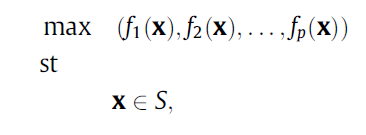Introduction
最近在Pyomo上继续学习怎么使用多目标优化,基于文章
Mavrotas G . Effective implementation of theε-constraint method in Multi-Objective Mathematical Programming problems[J]. Applied Mathematics & Computation, 2009, 213(2):455-465.
真的很佩服这种单枪匹马写出高水平论文的大佬。
Pareto optimal
The Pareto optimal (or efficient, non-dominated, non-inferior) solutions are the solutions that cannot be improved in one objective function without deteriorating their performance in at least one of the rest.
Conventional e-constraint method
example_1:

传统 e-constraint method 的思想:将f2(x)、f3(x)...fp(x)单独求最优后的值作为约束条件,这样求解的过程中,所有可行解都不会比该约束对应的解要低,满足了Pareto optimal 所要求的cannot be improved in one objective function 性质。
example_1变为:

传统 e-constraint method 的步骤(以example_1为例):
- 求解 max f1(x)为目标函数下,f2(x), f3(x)...fp(x)的值,这些值为对应function的可行区间端点值,记为f2_min, f3_min...fp_min。
- 求解余下各个objective function的值,max f2(x), max f3(x)...max fp(x),这些值为对应function的可行区间的端点值,记为f2_max, f3_max...fp_max。至此,得到了p-1个可行区间[(f2_min, f2_max),(f3_min, f3_max)...(fp_min, fp_max)]。
- 在p-1个可行区间内设定步长,得到Pareto optimal解集的个数。若设置每个区间内步长统一为n,则一个区间内可以得到(f2_max-f2_min)/n个解,p-1个区间内就有(p-1)*(f2_max-f2_min)/n。
- 进行p-1次循环,每次的步长值作为约束条件添加进优化模型中:
for i in p-1 for j in range(fi_min, fi_max, yourstep): model.e = i model.f2 <= model.e solve(model)
注意事项:
- 在求解过程中,求出端点值fi_min和fi_max后需要有一个比较过程,因为根据不同的算例,二者求得的顺序有可能相反,在规定步长的代码中最大值和最小值传入顺序(先大后小)要正确否则会报错。
- 在相应求解最小值的过程中,应改为
model.f2 <= model.e
Augmented e-constraint method
增广e-constraint方法主要是为了避免传统e-constraint法可能会遇到的支配解也进入解集中的情况,并对寻优进行加速:
一个小李子:
# min [f1(x)=x2-x1, f2(x)=x1+x2]
# st x1^2 - 2*x1 + 1 <= x2
# 0 <= x1 <= 1
# 0 <= x2 <= 1一个垃圾实现:
POT = ConcreteModel(name='Pareto Optimization Test')
POT.x1 = Var(bounds=(0, 1), within=NonNegativeReals)
POT.x2 = Var(bounds=(0, 1), within=NonNegativeReals)
POT.c1 = Constraint(expr=POT.x1 * POT.x1 - POT.x1 * 2 + 1 <= POT.x2)
POT.f1 = Var()
POT.f2 = Var()
POT.e = Param(initialize=0, mutable=True)
POT.c2 = Constraint(expr=POT.f1 == POT.x2 - POT.x1)
POT.c3 = Constraint(expr=POT.f2 == POT.x2 + POT.x1)
POT.obj1 = Objective(expr=POT.f1, sense=minimize)
POT.obj2 = Objective(expr=POT.f2, sense=minimize)
POT.obj2.deactivate()
solver = SolverFactory('ipopt')
print(solver.solve(POT))
# POT.display()
f1_min = value(POT.f1)
f2_max = value(POT.f2)
POT.obj1.deactivate()
POT.obj2.activate()
solver = SolverFactory('ipopt')
print(solver.solve(POT))
# POT.display()
f1_max = value(POT.f1)
f2_min = value(POT.f2)
POT.eCons = Constraint(expr=POT.f2 <= POT.e)
POT.obj1.activate()
POT.obj2.deactivate()
n = 10
list1 = np.linspace(f2_min, f2_max, n)
# step = abs(f2_max-f2_min)/n
# steps = list(range(f2_max, f2_min, step)) + f2_max
# steps.sort()
a = []
b = []
POT.del_component(POT.obj1)
POT.del_component(POT.obj2)
POT.del_component(POT.eCons)
POT.eps = Param(initialize=0.001)
POT.s = Var(within=NonNegativeReals)
POT.obj1 = Objective(expr=POT.f1 - POT.s * POT.eps, sense=minimize)
POT.C_e = Constraint(expr=POT.f2 + POT.s == POT.e)
#
#
for i in list1:
POT.e = i
solver = SolverFactory('ipopt')
solver.solve(POT)
a.append(value(POT.x1))
b.append(value(POT.x2))
plt.plot(a, b, 'o-.')
plt.title('efficient Pareto-front')
plt.grid(True)
plt.show()注意事项:
需要注意求解最大值和最小值时obj fun对于slack variable的操作: 
初中数学都忘了,搞了我一天,两行泪。

























 426
426











 被折叠的 条评论
为什么被折叠?
被折叠的 条评论
为什么被折叠?








